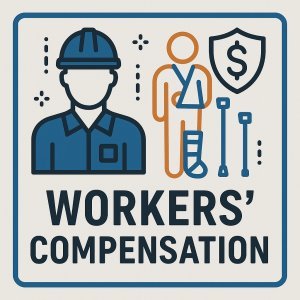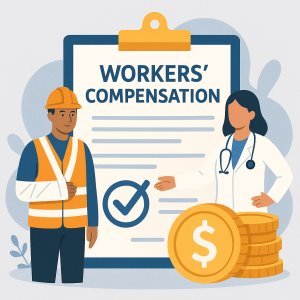
Workers’ Comp Insurance for GA Recruitment Agencies
August 25, 2025
How to Read Your Workers Comp Policy Declarations Page
August 25, 2025In the dynamic landscape of light industrial staffing,managing risk through a well-structured workers’ compensation policy is crucial for safeguarding both employees and employers. Building an effective workers’ comp policy tailored to the unique challenges of the light industrial sector requires a extensive understanding of operational hazards,regulatory requirements,and cost-containment strategies. This article explores key considerations and best practices for developing policies that not only ensure compliance but also promote workplace safety and financial stability in the competitive staffing industry.
Table of Contents
- Understanding the Unique Workers’ Compensation Risks in Light Industrial Staffing
- Tailoring Coverage to Address common Claims and Industry Hazards
- Implementing Effective Risk Management strategies to Lower Premiums
- Leveraging Technology and Data Analytics to Optimize Policy Design
- Q&A
- Concluding Remarks
Understanding the Unique Workers’ Compensation Risks in Light Industrial Staffing
staffing light industrial roles introduces a distinct set of challenges when it comes to workers’ compensation. Unlike conventional office environments, these workplaces frequently expose employees to risks such as repetitive motion injuries, slips, trips, and falls, and machinery-related accidents. The transient nature of staffing agencies often results in a workforce unfamiliar with site-specific hazards, which can increase the likelihood of workplace injuries. Proactively addressing these risks means understanding the complexity of variable work environments and emphasizing comprehensive safety training tailored to each assignment.
Failure to adequately manage these unique risks can lead to increased premiums and claims disputes. Key factors influencing workers’ comp risk in light industrial settings include:
- High employee turnover,resulting in inconsistent safety adherence
- Variable job tasks that often require different physical demands
- Diversity of client workplaces with varying safety standards
- Limited time for thorough risk assessments before job placement
A strategic workers’ compensation policy should incorporate flexible coverage options,emphasize pre-assignment safety orientation,and maintain close dialog between staffing firms and client sites to reduce exposure to these multifaceted risks.
Tailoring Coverage to Address Common Claims and Industry Hazards
Effectively managing workers’ compensation for light industrial staffing requires a nuanced understanding of the unique risks associated with this sector. Common claims frequently enough stem from repetitive motion injuries, falls, and machinery-related accidents. Tailoring coverage means going beyond standard policies to include provisions that address these specific exposures. Employers benefit from collaborating with insurers who can offer targeted risk assessments, allowing for proactive adjustments in coverage limits and endorsements that best protect both the workforce and the financial interests of the business.
Policy customization should also consider industry-specific hazards such as chemical exposure, forklift operations, and ergonomic challenges. Incorporating specialized training programs and safety protocols as part of the coverage agreement strengthens risk mitigation efforts. Below is a summary table illustrating common hazards and corresponding coverage adjustments to consider when building a workers’ comp policy for light industrial staffing:
| Hazard | Common Claims | Recommended Coverage Enhancements |
|---|---|---|
| Chemical Exposure | Respiratory issues, skin burns | Expanded medical benefits, environmental claims protection |
| forklift Operations | Crush injuries, collisions | Accident-specific injury coverage, safety equipment endorsements |
| Ergonomic Strain | Musculoskeletal disorders | Rehabilitation benefits, ergonomic injury prevention programs |
Implementing Effective Risk Management Strategies to Lower Premiums
Proactively managing risks within light industrial staffing environments not only fosters a safer workplace but also plays a critical role in reducing workers’ compensation premiums. By systematically identifying potential hazards and implementing tailored preventive measures, employers can effectively minimize incident rates and associated claim costs. Key strategies include:
- Conducting regular safety audits to pinpoint operational risks;
- Providing comprehensive training programs focused on job-specific hazards and proper equipment use;
- Encouraging early reporting and swift response to workplace injuries;
- Implementing robust return-to-work programs to reduce claim duration and facilitate recovery;
- Utilizing technology such as safety management software for real-time monitoring.
Additionally, quantifying the effectiveness of these initiatives through metrics and performance indicators allows for continuous refinement. The following table highlights an example of how a logistical tracking system can reduce incident rates over time,subsequently lowering premium adjustments in a competitive insurance pricing model.
| Quarter | Incident Rate | Premium Adjustment (%) |
|---|---|---|
| Q1 | 3.5% | +5% |
| Q2 | 2.8% | +2% |
| Q3 | 1.9% | -3% |
| Q4 | 1.2% | -6% |
By embedding such risk management strategies into operational protocols, staffing agencies position themselves to enjoy reduced financial liabilities while reinforcing a culture of safety and accountability.
Leveraging Technology and Data Analytics to Optimize Policy Design
Harnessing the power of advanced technology and data analytics is revolutionizing how workers’ compensation policies are crafted, notably for light industrial staffing. By integrating predictive analytics, insurers can assess workplace risks more accurately and tailor policies to reflect the unique exposure profiles of temporary and contract workers. Real-time data collection tools,such as IoT devices and mobile reporting apps,enable continuous monitoring of job site environments and employee health indicators,helping to preemptively identify hazard patterns and reduce claim frequencies.
Moreover, leveraging these technologies streamlines underwriting processes and enhances cost-efficiency. Insurers benefit from automated risk scoring algorithms that process past claims, environmental factors, and workforce demographics to generate precise premium calculations. Below is a simplified example illustrating how data inputs influence policy risk tiers, accelerating decision-making and improving portfolio profitability:
| Data Input | Risk Indicator | Policy Tier | Premium Impact |
|---|---|---|---|
| Claim Frequency | Low | Tier 1 | -10% |
| Employee Tenure | Short-Term | Tier 3 | +15% |
| Site Hazard Score | Moderate | Tier 2 | 0% |
- Enhanced risk segmentation for customized coverage
- Proactive injury prevention through early-warning systems
- Data-driven pricing models for competitive market positioning
Q&A
Q&A: Building a Workers’ Comp Policy for Light Industrial Staffing
Q1: Why is a specialized workers’ compensation policy important for light industrial staffing firms?
A1: Light industrial staffing firms operate in environments with unique workplace risks such as machinery operation, repetitive manual tasks, and temporary labor. A specialized workers’ comp policy addresses these industry-specific hazards, ensuring adequate coverage for injuries while controlling costs associated with claims and premiums.
Q2: What are the key factors to consider when building a workers’ comp policy for light industrial staffing?
A2: Key factors include understanding the classification codes for the types of work performed, accurately assessing the payroll for temporary and permanent employees, analyzing historical loss data, and customizing coverage limits. It’s also critically important to include claims management provisions tailored to transient workforces.
Q3: How does employee classification impact the workers’ comp policy?
A3: Correct employee classification is critical because the workers’ compensation premium is heavily influenced by the risk associated with specific job duties. Misclassification can lead to overpayment or meaningful penalties. For light industrial staffing, differentiating between roles like warehouse workers, machine operators, and clerical staff ensures the premium reflects actual risk.
Q4: What role does risk management play in controlling workers’ compensation costs?
A4: Proactive risk management reduces the frequency and severity of workplace injuries, which directly impacts claims and therefore premiums. Light industrial staffing firms should implement robust safety training, regular site evaluations, and timely incident reporting to mitigate risks and optimize their workers’ comp policy costs.
Q5: Are there any specific challenges staffing firms face in workers’ comp claims management?
A5: Yes, staffing firms often face challenges such as tracking claims across multiple client locations, managing return-to-work programs for temporary employees, and differentiating responsibility between the staffing agency and the host employer. Developing clear protocols and maintaining strong communication with clients and insurers helps streamline claims handling.
Q6: How can light industrial staffing firms leverage insurance partnerships to build effective workers’ comp policies?
A6: Partnering with insurance brokers and carriers who understand the staffing industry allows firms to access tailored policy options, competitive rates, and risk management resources.Such partnerships enable ongoing policy adjustments as the workforce and operational risks evolve.
Q7: What are best practices for staffing companies to maintain compliance with workers’ comp regulations?
A7: Staffing companies should stay informed on state-specific workers’ compensation laws, ensure proper employee reporting, maintain accurate payroll records, and regularly review policies to ensure they meet changing regulatory requirements. Leveraging technology platforms can help automate compliance tracking.
Q8: How does having a comprehensive workers’ comp policy benefit staffing firms beyond regulatory compliance?
A8: A comprehensive policy promotes workforce confidence, minimizes litigation risk, enhances client relationships through demonstrated responsibility, and supports business continuity by managing claims efficiently. Ultimately, it protects both the staffing firm’s financial health and its reputation in the marketplace.
Concluding Remarks
constructing a comprehensive workers’ compensation policy tailored for light industrial staffing is essential to effectively manage risk and protect both your workforce and your business. By carefully assessing the unique hazards inherent to light industrial environments and collaborating with experienced insurers,you can develop a policy that not only ensures compliance but also supports employee well-being and operational continuity.Investing the time and resources in a well-structured workers’ comp plan ultimately fosters a safer workplace and a more resilient staffing operation.
“This content was generated with the assistance of artificial intelligence. While we strive for accuracy, AI-generated content may not always reflect the most current information or professional advice. Users are encouraged to independently verify critical information and, where appropriate, consult with qualified professionals, lawyers, state statutes and regulations & NCCI rules & manuals before making decisions based on this content.







